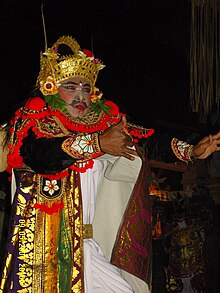Gambuh
 Gambuh performance depicting an arya or nobleman | |
| Native name |
|
|---|---|
| Instrument(s) | Gamelan |
| Inventor | Balinese |
| Origin | Indonesia |
| Three genres of traditional dance in Bali | |
|---|---|
Joged Bumbung, Barong Ket ) |
| Gambuh |
|---|
|
| Burma |
| Cambodia |
| Indonesia |
|
| Laos |
| Malaysia |
| Philippines |
| Thailand |
|
| Vietnam |
 |
| Music of Indonesia |
| Genres |
|---|
|
| Specific forms |
|
|
|
|
|
| Regional music |
Gambuh (Balinese: ᬕᬫ᭄ᬩᬸᬄ) is an ancient form of Balinese dance-drama. It is accompanied by musicians in a gamelan gambuh ensemble.
History
Gambuh is one of the oldest surviving forms in Balinese performing arts,
Gambuh is mainly preserved in one village, Batuan. In 1997, Susilo observed, "In total there are perhaps only four groups that perform in the Gambuh style."
Dramatic components
Combining dance, music, and acting, gambuh draws on the narrative material of the Malat, a long poem about the fictional Javanese prince,
Gamelan gambuh
A complete gamelan gambuh requires approximately 17 musicians to accompany the dance-drama. The main instruments in gambuh performances are very low bamboo flutes, called suling gambuh, between 75 and 100 cm in length and 4 and 5 cm in diameter. There are usually four such flutes, but sometimes only as few as two or as many as six flutes are employed.[5] The suling gambuh play melodies along with a rebab while percussion instruments fill out the sound with a variety of timbres and rhythms: a medium-sized gong, a small gong called kajar, two kendang, a chime called klenang, a bell tree called gentorag, rincik (reminiscent of a ceng-ceng), a metallophone called kenyir, kangsi, and gumanak.[1][3] The last three of those instruments—the kenyir, kangsi, and gumanak—are not currently found in any other gamelan ensemble of Bali.[5]
Gallery
See also
References
- ^ a b c d Dennis Kennedy, ed. (2003). "Gambuh". Oxford Encyclopedia of Theatre and Performance. Vol. 1. Oxford University Press. p. 495.
- ^ JSTOR 834127.
- ^ ISBN 0-945971-30-3. Page 20.
- ^ a b c d e f Emiko Susilo (1997). "Gambuh: A Dance-Drama of the Balinese Courts in Explorations in Southeast Asian Studies: A Journal of the Southeast Asian Studies Student Association, Vol 1, No. 2, Fall 1997". University of Hawaiʻi Southeast Asian Studies Student Association. Archived from the original on 2010-06-04. Retrieved 2011-04-27.
- ^ a b I Nyoman Rembang; I Wayan Sudiana; Tilman Seebass; Wayne Vitale (eds.). Music Gambuh Batuan dan Pedungan.












